Student Blog
Catherine

Excited for the Future ⟩
April 27, 2020, by Catherine
As I wrap up the Spring semester and prepare to depart from my role as the OTD ambassador, I have reflected on impact pursuing the clinical doctorate degree has made in my future as a clinician, and how this particular year of the program has shaped how I view occupational therapy as my career choice. To say the least, this has been a whirlwind year of change, achievements and unforeseen challenges. Transitioning from the master’s program into the OTD, I have transitioned from an OTS to an OTR/L, found new inspiration and meaning in our profession through my residency in support of the Occupational Science Symposium, and have alongside my Trojan family, faced the unforeseen challenges of COVID-19 as a community.
It is no doubt that this novel global pandemic has drastically changed our daily occupational routines. The normalcy of occupations may change when we re-emerge from social distancing, but we are adaptable. As occupational therapists, I am grateful to my mentors, peers and colleagues that have provided the insight to make these changes positive, and training guide them through meaningful occupations. We are armed with clinical reasoning, therapeutic communications, and the OTD has enriched my experiences to see through a holistic lens rooted in evidence-based practice.
In the seminal paper, “An Introduction to Occupational Science, A Foundation for Occupational Therapy in the 21st Century”, Yerxa et al. (1990) wrote:
The concept of occupation and its application in occupational therapy are great ideas whose time has come. For, one of the greatest challenges society faces today is understanding the relationship between engagement in occupation and health. We are filled with excitement about what this idea has to contribute to humankind in the twenty-first century. It has the potential to improve the lives of legions of people, both people with disabilities and other people, if we can nurture its development and maturation. (pp.1-2)
It is as though the early founders of occupational science had a crystal ball. Because as we collectively re-integrate into our society and continue to face safety measures to guard against COVID-19, the challenges we face will no longer solely depend on our infection rates, but how to thrive and live well in the process. Like the founders were 30 years ago, I am excited for the possibilities that lie ahead in our profession. As health professionals we stand in solidarity, focused on our short-term goal of the upmost importance, contributing our part in the efforts to flatten the curve; but we also have the long-term goal. The long-term goal to live our best lives, through the engagement in occupations, towards improvements in the health and well-being of our clients and communities, as we OTs do best.
I continue to be grateful and inspired by our Chan community’s resilience, hope and compassion, and continue to look forward to the contributions future Trojans will pave the way for in the future. It has been an honor and privilege to share my journey through the OTD. Fight on!!
Reference
Yerxa, E. J., Clark, F., Frank, G., Jackson, J., Parham, D., Peirce, D., . . . Zemke, R. (1990). An introduction to occupational science, a foundation for occupational therapy in the 21st century. Occupational Therapy In Health Care, 6(4), 1-17. doi:10.1080/J003v06n04_04
⋯

Wake Up Call ⟩
April 9, 2020, by Catherine
Last week, I wasn’t feeling so great. It may have been the constant news being consumed or the overall sense of anxiety that has accompanied the new norm. While the rationale part of me knew that it was very unlikely that I had been infected with COVID-19, the wave of “what ifs” and leaps of the imagination to the worst case scenarios could not be stopped. Long story short, after some rest, extra fluids and time away from the news, felt better. It was my body telling me that I needed to slow down. The unforeseeable changes and disruptions in my daily occupations had challenged my wellbeing and had created unfamiliar reactions.
As an OT, my tool box is filled with strategies and interventions to help others, my focus had been on making sure my family and friends were adjusting the best way possible. I was not being mindful of my own needs, and as a result had burned out. Caregiver and provider burnout has been a topic of discussion throughout the master’s and clinical doctorate programs. Managing a household, residency and school assignments, from the same physical space has forced me to wear multiple hats at once. In the beginning, like many others, I jumped into action, trying to provide a safe environment for my family to cope. In the process, forgetting about myself.
Ironically, I had researched and developed a program during my Level 2 fieldwork, to provide providers in a hospital setting, strategies to respond to the state of vital exhaustion that was caused by emotional exhaustion, depersonalization and the overall decreased sense of personal accomplishment. Now more than ever, the current pandemic has created a constant state of fight or flight adrenaline rushes in our communities, to our healthcare frontline workers and other positions of essential service providers, and to our individual selves.
Best practice recommendations include initiating a wellness audit of the workplace, where the leadership would support the team of care providers in identifying sources, providing education and resources, and encouraging team members to express needs and set SMART goals to promote work life balance. Evidence also supports that in times of burnout, being mindful of our core values helps us stay grounded and motivated towards our personal and professional goals in difficult times. I have seen that many of my colleagues who enter healthcare professions share a common passion of helping others, empowering them to thrive in their everyday lives. But in times like these, I want to remind us all that we not only should be compassionate to the needs of others, but our own as well.
On that note, I would like to share some occupations that are important to me and have helped me re-calibrate and stay grounded.

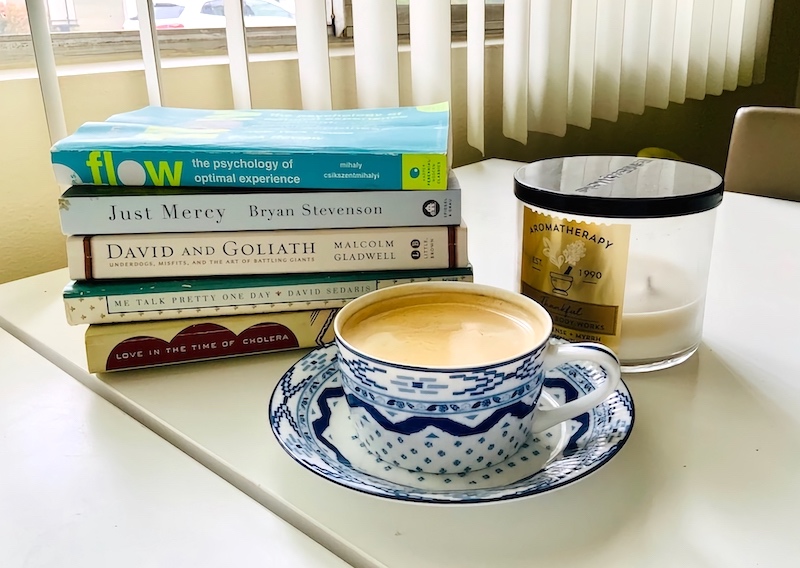
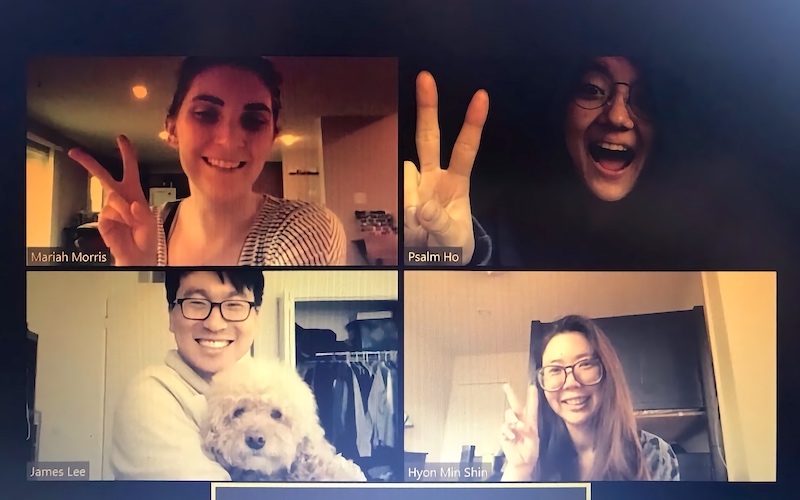
Also, if you are willing and able, I invite you to help out our frontline healthcare and essential workers in your area. If you are in the LA area, and would like to help out our frontline workers at Keck, please visit this website. Together we will fight on!
⋯

When You Have a Full House Sheltering in Place ⟩
March 23, 2020, by Catherine
Having just come back from Spring Break, many of us are trying to figure out our new routines. I am grateful that despite being an international student, my family and I are together, safe and well. Nevertheless, living in a house with a kindergartner, a fourth grader, two active older adults, and two adults working remotely makes one full house. Boundaries need to be set in place, while new structures will need to be created while some old ones must be maintained. As the resident OT in our home, I have set some new house rules that I hope will pull us through, and might inspire some ideas for you.
- Get out of your pajamas. Despite having to stay home all day, we still have school and jobs to attend to. Maintaining our morning routines as though we actually have to leave the home has been helpful in getting the day started. Getting a little dressed up before I sit down in my work area has helped me get in the zone and stay focused. I have seen that this has also worked with the kids. Getting into their school clothes has reminded them that we are not on an extended vacation, but trying to go through business as usual.
- Separate your space. Even before the struggles of “shelter in place” we had heard countless times that it is helpful to separate our work and rest space for our mental and physical health. While working remotely has been a privilege, it can sometimes feel that I am constantly working, when I am never able to leave the confines of my desk in my bedroom. To address this, I recently moved all work related materials into our shared “office” aka the dining room table that we rarely use. This has become our new space where we each do our respective school assignments and work. A makeshift open office space if you will. When we are sitting here, we are learning to be respectful of our time, but I can see that it is also teaching the little ones to practice social etiquette. Nevertheless, I am just one poke away to answer any geometry questions should they come up.
- Make yourself a quiet place. During the unpredictable and challenging times we live in today, a quiet place to meditate, think, and even just breathe for a couple minutes have been a luxury. Social distancing aside, as a caregiver and a member of the “sandwich generation” sometimes you need to give yourself some me time. Especially if you can hear children screaming in the background for 90% your waking hours, silence is golden. I have found that the car has been a refreshing place of a few minutes of peace and quiet.
- Don’t forget to connect to other people. While I can not emphasize enough how much I love my family, it has been important to keep in touch with those I am not blood related to. Thanks to the internet and all the apps out there, I have been able to stay connected with my network. Whether it be through text or video chat, or just commenting on posts, it’s good to stay connected and check in.
- Communicate. Sometimes when we are with our family we can forget basic communications. We can make assumptions that we fully understand each other’s needs, leading to more misunderstandings and possibly even hurt feelings. Extended periods of close connectedness, can be met with unexpected challenges we may not have anticipated. For example, when I need to concentrate, I prefer a calm environment, but my sister does her best work when she is talking and walking in circles, and prefers to use her speakerphone. I never knew this until we tried to share a work space and I will leave the details out, but you probably can imagine. Through open communication we were able to reach a compromise. I gifted her a pair of wireless earphones and she has agreed to take her important calls on the lawn.
These are just some reflections on my attempts to create some balance and productivity while we adapt to our current state of life in my family. I hope to continue to share with you my progress with any new ideas or updates that I think may be helpful or entertaining. As always, I am here for all of you who may have any questions about my life as an OTD resident, student, and as a resource of support. Fight on!
⋯

Reflections on Gender, Leadership and the OTD ⟩
February 24, 2020, by Catherine
I knew I had found my forever occupation (the other definition), when I first walked through the CHP hallway’s “Walk of Fame” adorned with the portraits of Trojan giants of our field: Margaret Rood, A. Jean Ayers, Elizabeth Yerxa, and Florence Clark (just to name a few). It was as if their legacies emanated through the halls, empowering me to make hard pivot, leaving behind my past career managing corporate transactions to delve into the meaningful, life changing profession that is occupational therapy.
Prior to Chan, I attended a small women’s liberal arts college for my undergraduate degree here in the US, and a larger women’s university for my MBA in Korea. I was surrounded by a false sense of security that gender was not an issue, and that my intellect and skills were all I would need to achieve my career goals. Following my interests, I found employment in finance, technology, entertainment, fashion and journalism.
Entering the working world was a wake-up call. The stories of the glass ceiling are real, and in my personal experience, every industry and profession has invisible obstacles for women to succeed. Navigating corporate structures, traditional policies, and the socially embedded expectations for women are hurdles that are no easy feat to overcome alone. In a recent report by World Economic Forum’s the US ranked 53rd out of 153 countries on gender parity, “focusing on four main themes: economic participation, educational attainment, health and survival, and political empowerment.”
While occupational therapy has been one of the few professions that has been dominated by women for over a century, stereotypes about our gender, lack of awareness of the value of occupations, and what occupational therapists bring to the table are the very real barriers practitioners face in the workplace. In fact, research has shown that “Though they may feel discomfort in a feminized field, men do not face structural barriers in occupational therapy . . . In such jobs, men are disproportionately pushed into management positions, with better pay, more prestige, and less hands-on care” (Beagan & Fredericks, 2018). It was no wonder that I was in awe of our “Hall of Fame”.
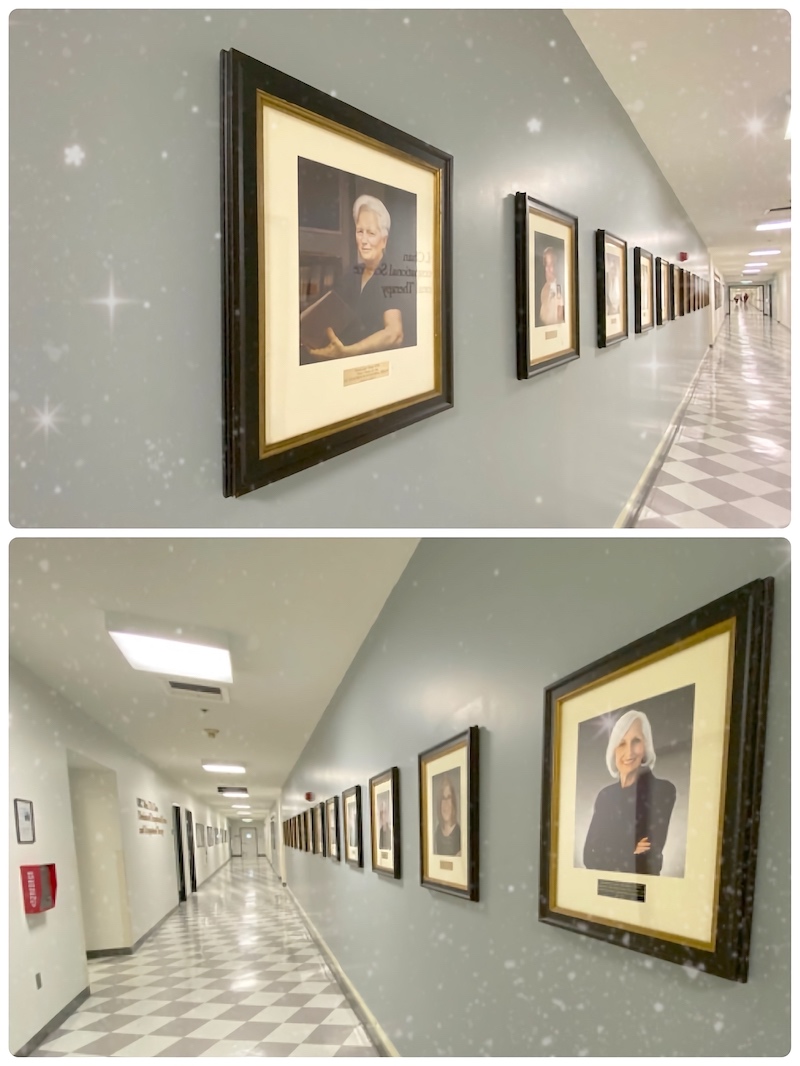
The Hall of Fame in the main hall of USC Chan
The OTD is a year long program that not only has allowed me to deepen my clinical understanding of meaningful, occupation focused interventions for my clients; it has given me an opportunity to hone my leadership skills and is preparing me to be a leader in my own right. The core courses and faculty mentorship has been integral to this process. The continuous achievements of the USC Chan Trojan network, highlighted in our news fueling the fire. I am inspired and energized to follow in their footsteps. I hope all women in their prospective industries are able to find strong mentors in their field, but if you are an occupational therapist, I sincerely believe there is no better place than the OTD program here at Chan to make that a reality.
Beagan, B. L., & Fredericks, E. (2018). What about the men? Gender parity in occupational therapy. Canadian Journal of Occupational Therapy, 8(2), 137-145. https://doi.org/10.1177/0008417417728524
Jacson, S. (2019, December 23). It will be 257 years before women have equal pay, gender gap report says. NBC News. https://nbcnews.com/news/world/it-will-be-257-years-women-have-equal-pay-new-n1103481
Yeung, J. (2019, December 17). Global gender equality will take another 100 years to achieve, study finds. CNN Business. https://cnn.com/2019/12/17/asia/gender-pay-gap-uk-wef-intl-hnk-scli/index.html
⋯

Why I use a paper planner . . . in addition to all my synced ones. ⟩
February 3, 2020, by Catherine
This weekend I had the opportunity to go to Newport with my family. Despite being a couple of weeks into the semester, meaning I am now revving into full gear of balancing residency, classes and my private life, one of the benefits of living in the Los Angeles County area is that no matter where you are living, you’re never too far away from some fun in the sun. Luckily, having visitors from out of the area always gives us the excuse to take full advantage of this.
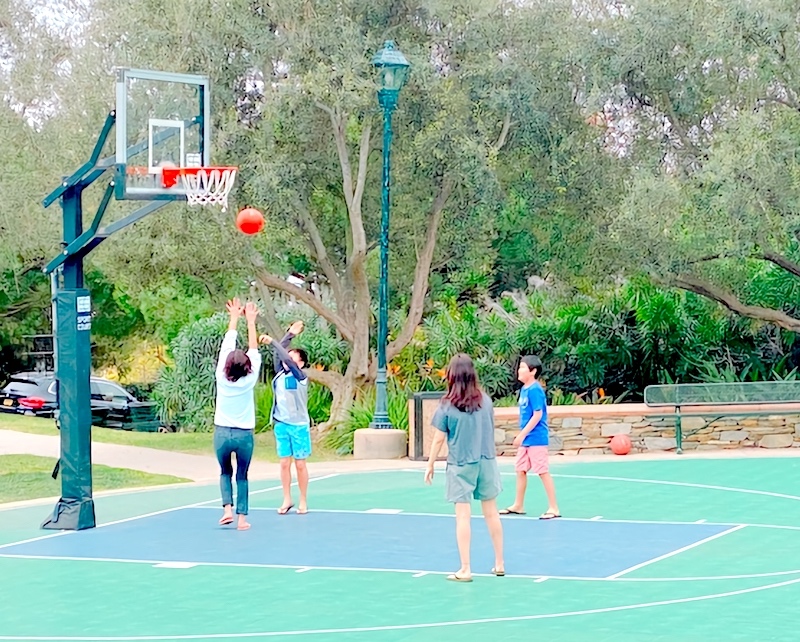
Throughout my experience in the OTD program, I have found that it is helpful to not only develop a planning system that works for me, but to also to set realistic timelines for how much each task will take. Balancing the schedules of my family members with my own has taken a considerable amount of trial and error, but I’ve found a way that has worked for me and my family.
First is my schedule, it has been natural to utilize the Google Calendar and Outlook applications that connect seamlessly with my USC and Chan email accounts to make sure I am on top of any event invitations offered by the school, and any meetings that may be scheduled throughout the semester. I have been able to subscribe to my nephews’ school calendars that are automatically synced to my Google Calendar, so I can be aware of any school events or holidays in advance. This has allowed for a nicely organized monthly calendar on my laptop.
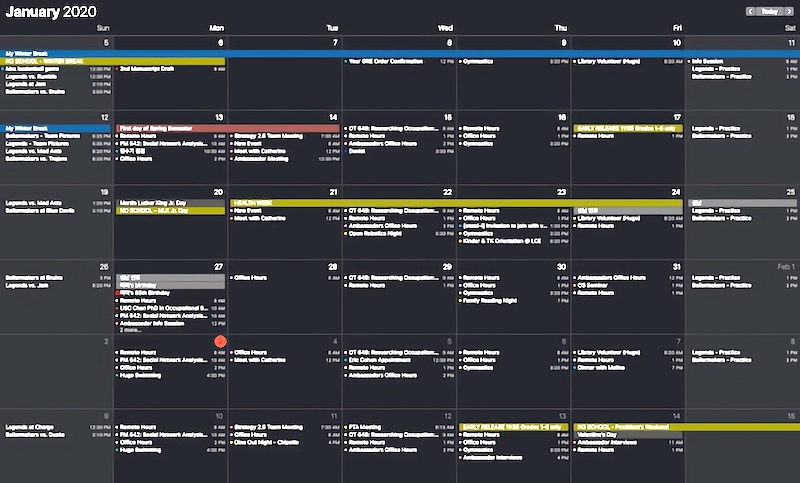
However, this can sometimes get a bit cluttered. While de-selecting some calendars will help in visual clarity, I have a secondary paper planner that I use to organize and orient myself daily.
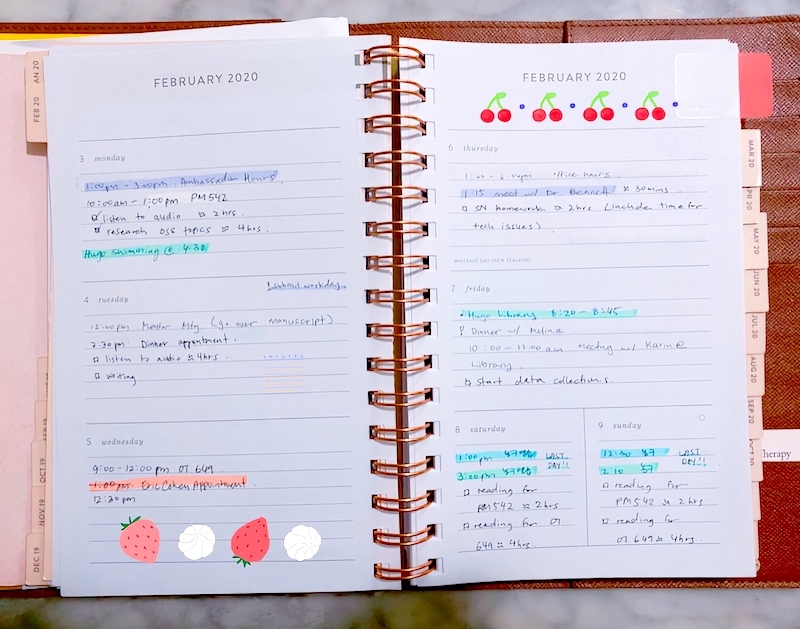
I use this as my daily mental practice of calm. Going through my “master calendar”, cross referencing with my shared calendars, and then prioritizing my tasks into a to-do list. In my experience, taking about 10 minutes every morning to do this has been very helpful not only in keeping track of my tasks, but giving me a minute to connect with what is meaningful to me personally, and motivating me throughout my day.

With this daily practice, I am able to stay on track, plan my week, and make sure I make the time for not only my work, school, but for those special memory making moments with my loved ones.
⋯





